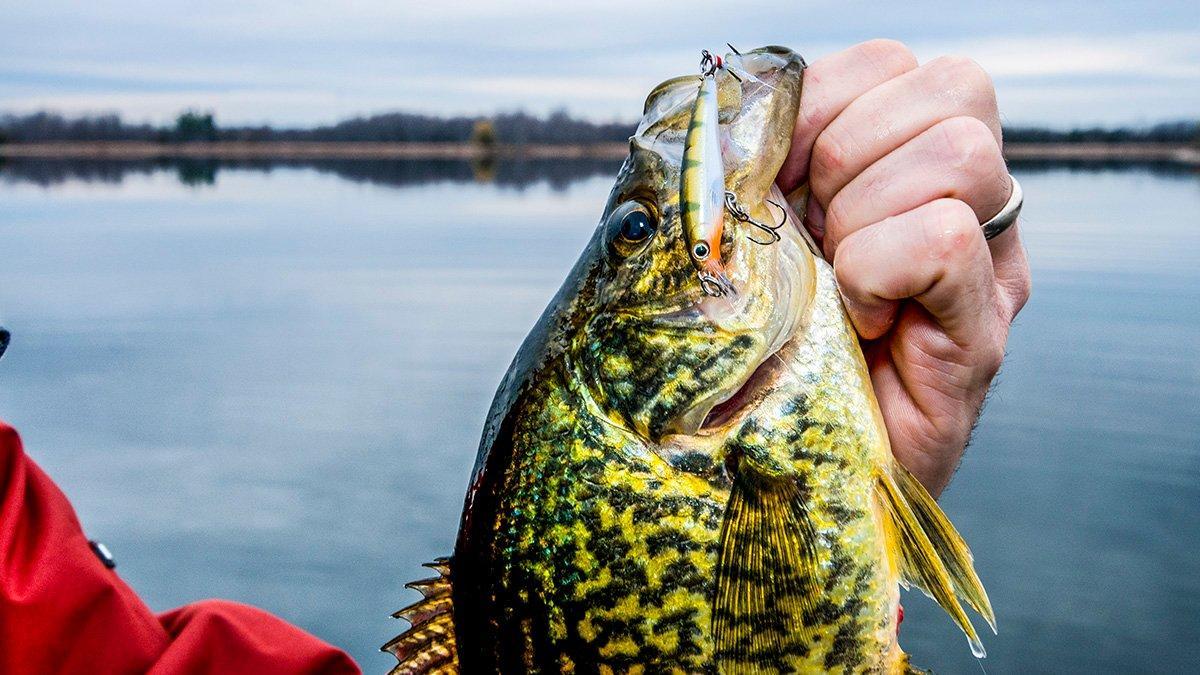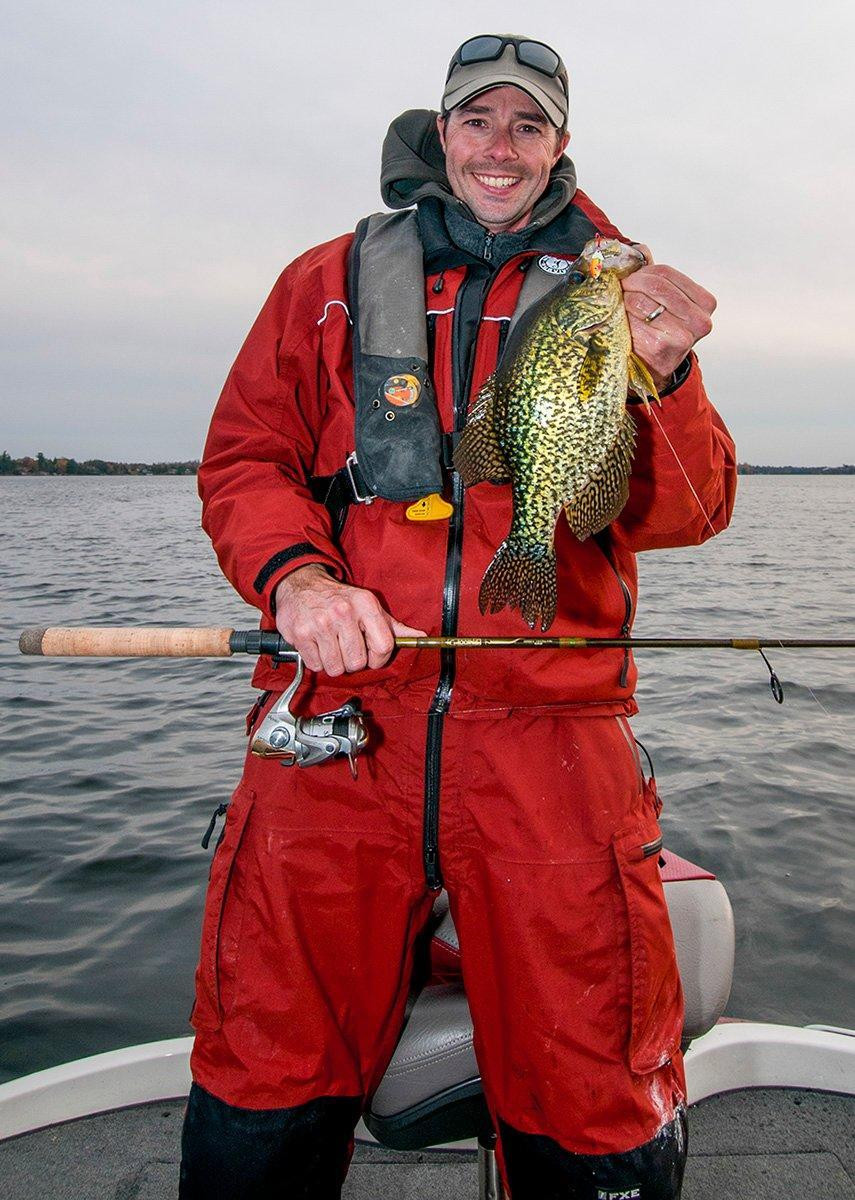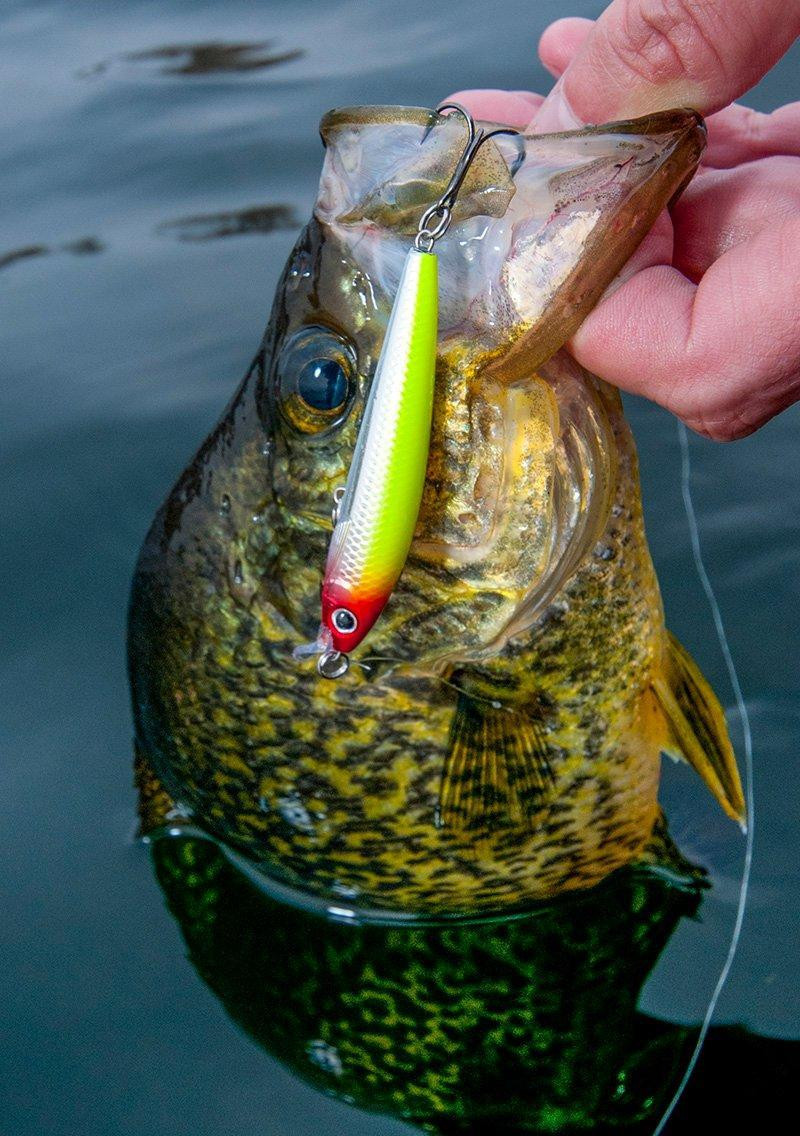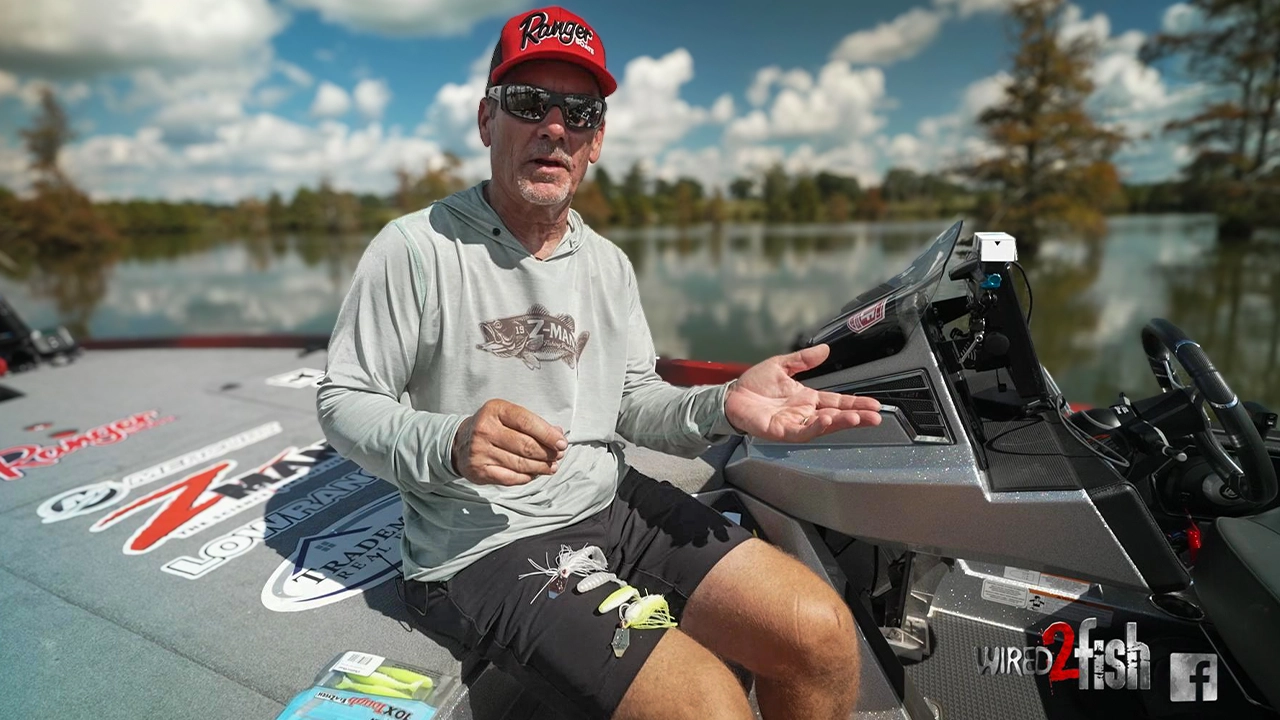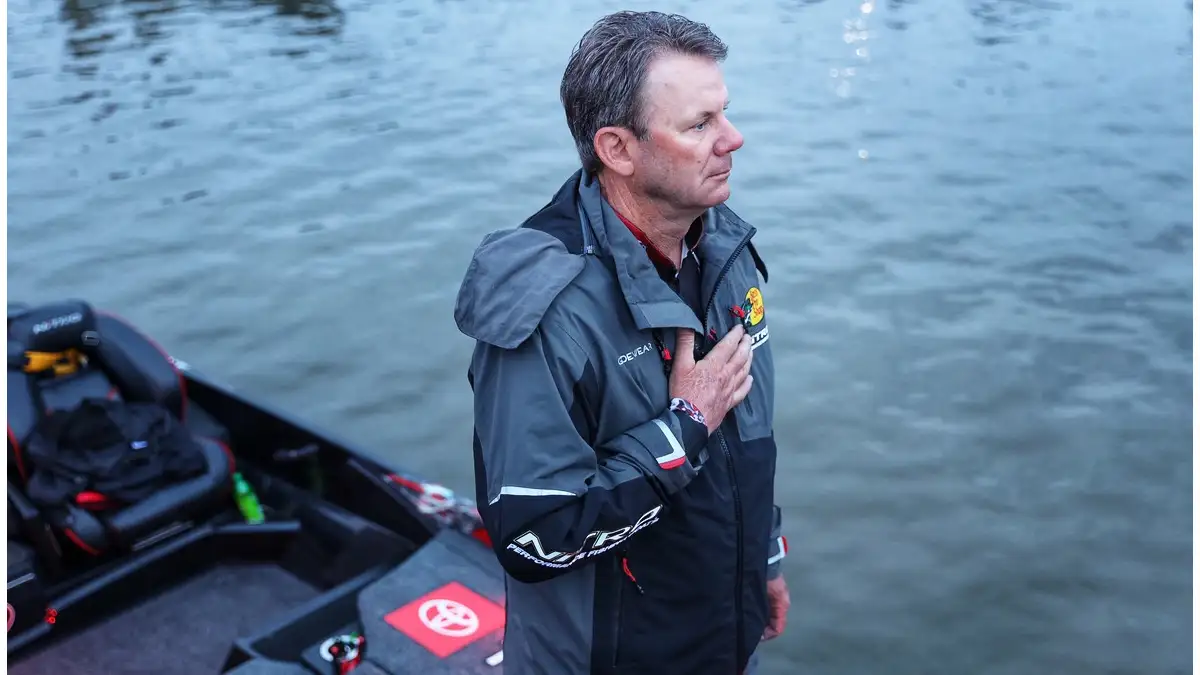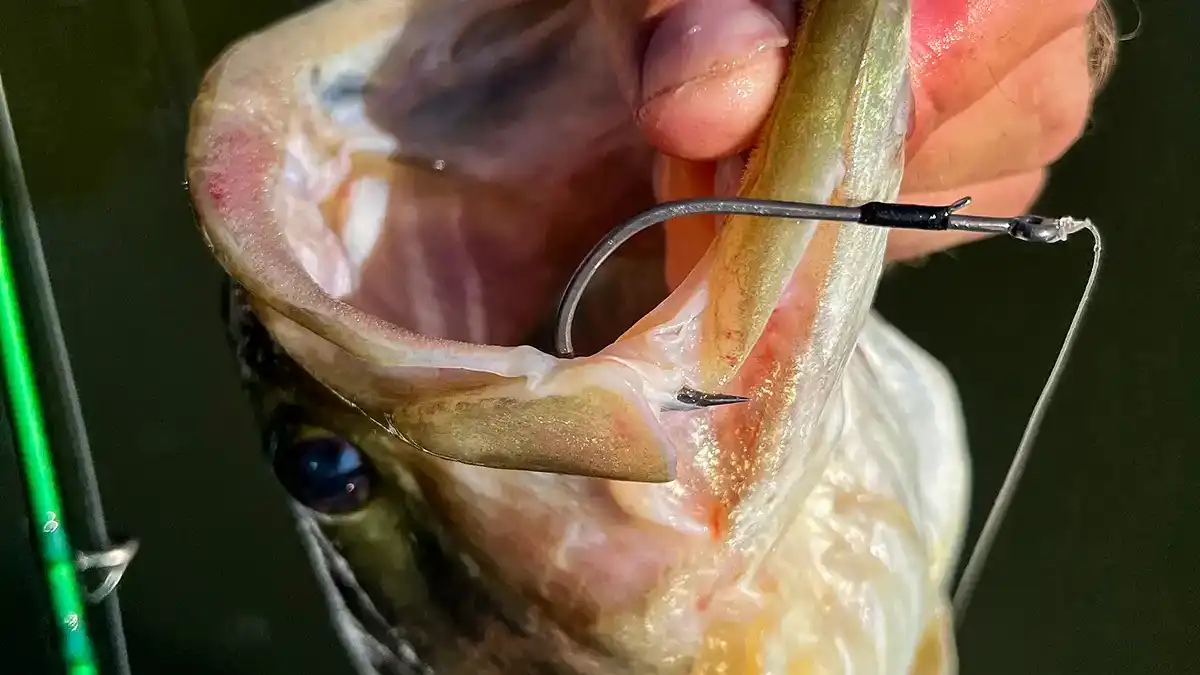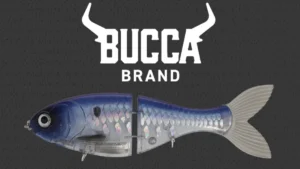Anglers casting minnow baits and spoons find and catch big crappie from mid-depth spots in the fall. Healthy grass beds, rocky reefs, points and islands near lake basins and deep flats comprise the best ares to find crappie. Casting small hard baits gives anglers the agility to quickly cover an area to find suspending or scattered slabs. More, minnow baits and spoons trigger aggressive hits from hungry crappie looking to eat big meals before winter arrives.
If your crappie tackle box mainly has soft plastics, you’re missing two very important tools for catching fall crappie. Here are 4 things to consider when casting small hard baits and spoons for fall crappie.
- Hard-bait selection
- Track them down
- Fall spots
- Application tips
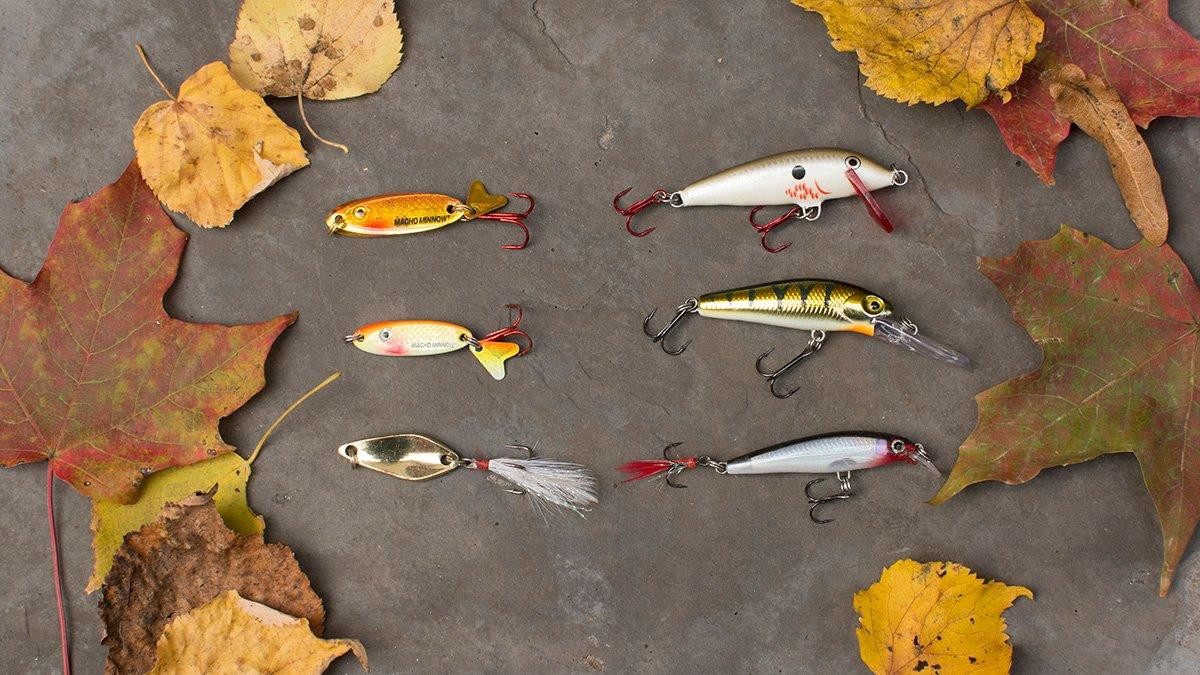
Hard bait selection
Minnow baits between 1 1/2 to 2 1/2 inches see a lot of action from my boat in fall. The baitfish profile appeals to big fish scarfing down calories before winter. Samples include the Rapala X-Rap and Countdown Minnow, Storm Lures Deep Baby Thunderstick and Rebel Tracdown Minnow.
On a pull-pause or reel-stop retrieve, a minnow bait swims like a panicking, or injured, baitfish. The belly roll creates flash and vibrations. This commotion works great for attracting crappie. A pause in the retrieve’s the secret to triggering a bite.
Carry floating, suspending and sinking minnow baits. Use each to work different sections of the water column.
Small, 1/16- to 1/8-ounce casting and cut-slab spoons are good picks for crappie in fall. The Lunkerhunt Micro Spoon, Johnson Splinter, Northland Fishing Tackle Macho Minnow and VMC Flash Champ spoons are examples.
A slow, swimming retrieve with occasional lifts and stops is all it takes to get a spoon wobbling, tumbling and catching crappie. On lakes where crappie see a lot of plastic presentations, a spoon can work wonders on lock-jawed slabs.
Minnowbaits and spoons fish well on a 6-foot, 6-inch to 7-foot light to medium-light spinning rod with 8- or 10-pound braid and a 6-pound fluorocarbon leader. Use a micro-swivel to join the lines and eliminate twist caused by spoons.
Track them down
While not universal, most minnow baits and spoons cast far. This is useful for fishing areas fast. Covering water’s key to locating scattered and suspended crappie.
Quickly dissecting an area also helps follow roaming fish. Crappie like to cycle – or circle – through areas.
This is a common scenario. I fancast a minnow bait to stay in contact with the school of crappie as they roam through 8 to 16 feet of water. Crappie like to swim along a weedy finger, travel over a deep grass bed, then turn around in a wide loop where the grass thins out. Their pace and path varies, so when I lose contact with the school, a series of long casts helps me pinpoint their position and start catching them again.
Fall casting spots
Casting minnow baits and spoons is a mid-depth fall strategy. Here are 5 things to consider when deciding where to do it.
- Think food – Fall crappie are a hungry bunch, so the best spots are near a good supply of forage.
- Find green – Crappie love deep, healthy grass in natural lakes. The greenery provides cover. It’s also home to minnows and invertebrates slabs eat. As an example, a deep grass bed in front of a spawning bay’s a prime location.
- Work edges – Crappie like outside grass edges. Fingers and bends stack-up slabs, too. Isolated clumps on a soft bottom flat also hold fish.
- Spot stones – Rock can be good. Think stony islands, reefs on flats and points. Some grass or timber mixed in never hurts.
- Near deep water – Most fall crappie hotspots are beside deep water. Lake basins and deep flats are a crappie’s destination for winter. Mid-depth fish are just enjoying the spoils of quality mid-depth food, before becoming permanent deep-water residents come cold water.
Application tips
Many minnowbaits and spoons used for casting crappie are downsized versions of bass baits. Given this, there are similarities for using these lures for crappie. There are also differences. Anglers should consider these 5 tactics when casting hard baits for crappie.
1. Count-down sinking baits
“One Mississippi, Two Mississippi…” Counting-down a sinking bait’s important. I find 3 to 6 seconds works well when probing mid-depths in fall. Every bait sinks differently and slabs can suspend at any depth. Consider this range a starting point.
Vary the depth the lure’s allowed to sink every few casts until you catch a fish. Then repeat it. Anglers who remember this detail net more slabs.
2. Keep contact with the bait
Maintaining a feel of a lure’s critical. This may sound like Fishing 101, but it’s essential for catching light-biting crappie.
When using a ripbait for bass, the rod’s twitched then pointed back at the lure to encourage maximum action. This is not recommended when fishing minnowbaits for crappie.
I’ve experimented while sight-fishing slabs in clear water. On slack line, a crappie can easily inhale and spit out the minnowbait without transmitting vibrations up the line.
Swim the lure a couple feet at a time with the reel, then use small rod twitches or light pulls to vary its speed. Next, get the bait to stop (or slow down significantly), but keep slowly retrieving line. Do this by either slowly reeling or sweeping the rod forward. This is done so the line maintains a slight bow in it for immediate strike detection. Semi-taught line will jump when a crappie bites. If a slab hits hard, an angler feels the force of the strike, which is half the fun of casting hard baits for slabs.
The same logic applies to spoons. When using a swim-stop retrieve, keep the rod in the 10 o’clock position and let the spoon pendulum down on taught to semi-taught line.
3. Cast away from cover
When fishing grass, it’s common for anglers to park in deep water and cast shallow. This catches crappie. No arguments here.
On tough daytime bites, though, doing the opposite can pay off. Position the boat on the inside of a grass line or drop off. Then, cast a sinking lure into deep water, retrieving it shallower. This technique’s deadly at catching big slabs suspended over deep water but still relating to grass lines and weed clumps.
4. Throw metal around grass
Cast a spoon around grass. It isn’t weedless, but it’s amazing how certain models sidestep hang-ups in light cover.
Long casts work for retrieving a bait over the canopy. Use short pitches for probing lanes and outside edges. Watch the lure and use the rod to steer it clear of snags.
Casting minnowbaits and spoons is a reliable way to find and catch big crappie in the fall. Focus on mid-depth areas holding baitfish and always maintain contact with the lure. Do this, and you’ll boat plenty of slabs this fall.


